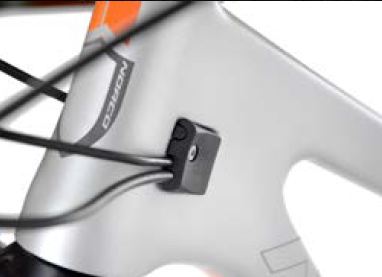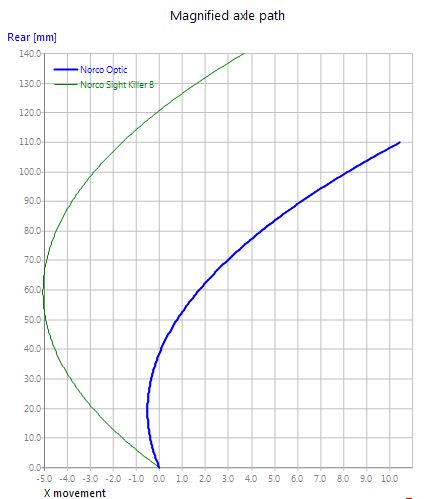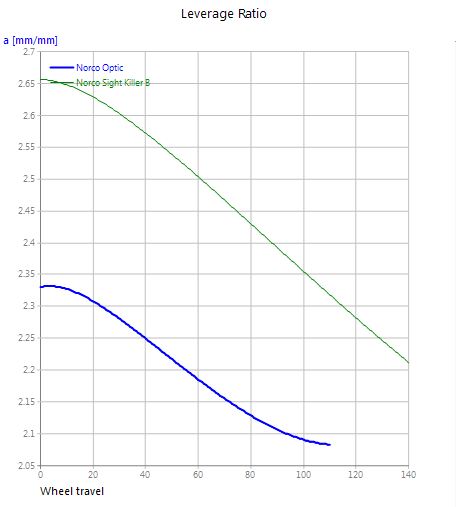New Breed of Norco

Norco has gone from strength to strength in recent years, with great bikes like the Sight and Range earning fans around the globe. More recently they’ve revamped their cross-country bikes too, with the Revolver and Revolver FS bringing some Canadian bred trail capability onto the XC race circuit.
The all-new Optic now slots into the middle ground, offering modern trail oriented geometry with a bit less travel than the Sight and Range. It’s available in both 27.5 and 29 inch versions, and the travel stands at 130/120mm (front/rear) with the smaller wheels and 120/110mm (front/rear) with the big wheels.

Geometry is the Key
It’s very much a new-school bike, with short chainstays, a moderately slack head angle, steep seat angle and a long front end that plays nicely with a short stem to provide precise steering. What makes the Optic particularly interesting is how closely the 29-inch version mirrors its smaller wheeled sibling. While there are a few exceptions, most 29ers tend to have longer chainstays than their 27.5 inch counterparts. In this case, Norco has used the added clearance created by the new boost drivetrain standard to tuck the rear wheel in close to the bottom bracket. Norco has been so successful that the 29er Optic has the same chainstay lengths as its 27.5 inch counterpart; as short as 425mm in a small 29er!
As with their other models, Norco varies the chainstay length to suit different frame sizes; a medium runs 430mm stays while a large is 435mm and the XL gets 440mm stays. Again these dimensions are mirrored in both wheel size options.

The wheelbase length is also very close; there’s no more than a few millimetres between the 29 and 27.5 inch bikes for a given frame size. At 68.5 degrees, the head angle is slightly steeper on the 29er—the 27.5 version comes in at 68-degrees flat. This affects the reach figure and makes the 27.5 bike a fraction shorter up front, but Norco compensates by fitting a slightly longer 60mm stem to achieve the same overall cockpit length (they’re calling this concept ‘Reach Plus’).

At the end of the day, the Optic maintains remarkably similar geometry across the two wheel sizes. When it comes to picking your preferred option, you’ll need to consider the suspension travel and the slight difference in ride feel. Smaller wheels have less rotating mass which improves agility. If you ride hard in rocky terrain you can run burly tyres with less of a weight penalty too. Wheels on the ground riders will appreciate the roll-over advantage of the 29er while the bump-boosting air catching crowd may choose the 27.5 bike for its additional travel and stronger wheels. It’s your choice either way but both feature exceptional frame geometry that’s very much in line with modern thinking.
Size wise, the 27.5 Optic is offered in a total of five different frames; from extra-small through to extra-large. The 29er misses out on the XS option but the remaining four sizes are catered for by the bigger wheels.

Suspension Tech
Norco continues with their ART suspension system on the Optic; it’s a Horst Link design that’s been tweaked to provide the desired characteristics. With this, it’s interesting to note that not all ART suspension equipped bikes share the same kinematics. Suspension design is always a delicate balancing act between providing a solid pedalling platform (lots of anti-squat) whilst allowing the suspension to remain active under hard pedalling (you can’t really have both at once).
With bikes like the Sight and Range, you’ll notice that Norco positions the rear Horst Link pivot well below the rear axle. This creates a distinctly rearward axle path that helps the suspension better handle square edge bumps. It also produces high levels of anti-squat that give these bikes a firm platform under pedalling loads. On the flipside, it also produces more ‘chain growth’ and some noticeable kickback through the pedals if you hit a decent sized bump whilst pedalling.

Look at their newer Revolver FS and you’ll notice the rearmost pivot is higher up and closer to the rear wheel axle—more like what you’ll see on other Horst Link bikes. With this, the axle path won’t be as rearward but there is less kickback through the cranks and the suspension remains more active under hard pedalling loads.
When we reviewed the Revolver FS we found there was a bit of suspension squat under power but the payback came when tackling root riddled climbs where the suspension remained totally active and it kept the tyre glued to the trail.
With the Optic, the ART suspension is closer to the Revolver FS than the Sight or Range. As a result we expect it to be quite active for technical climbing but a bit of extra platform damping may be needed to maintain an efficient pedalling feel on smoother climbs. On this front, all Optic models come with a Fox EVOL rear shock; these run a three position DPS switch that allows you to tune in the desired amount of compression damping.
One thing that does follow through from the Sight and Range models is the progressive leverage ratio. This combined with the Fox Evol air can ensures the suspension is extremely supple in the early travel. Our brief opening ride on an Optic A9.1 confirmed this; the suspension glides effortlessly into its travel, allowing it to stay glued to the trail. When it comes to bigger hits, progressive nature of the ART design prevents the bike from bottoming too easily. Progressive suspension is best suited to hard charging and aggressive mountain bikers. If you're a tentative rider, you mightn't use all of the available travel on a progressive bike, so in some cases a linear or falling rate suspension may be preferable.

If you like to geek out on a bit of suspension tech, scroll down and check out our analysis from the Bike Checker Linkage program.
Spec Options
Looking beyond the two wheel size options, the Optic will also be offered in alloy and carbon versions as well as a range of spec levels. Pricing will start with the alloy framed A9.2 and A7.2 (27.5 wheels) at $3,499. At this point you get a SRAM GX 1X11 drivetrain and a RockShox Sektor fork. Selling for $4,249, the Optic A9.1 (and A7.1) is the top alloy model. While it also has a SRAM GX drivetrain, it gets an upgraded RaceFace Cinch crank, Fox 34 fork and a KS dropper post (it’s the bike pictured here).
The carbon Optic will be offered at three price points. They start with the C9.3 (and C7.3) at $4,999. Again this uses a SRAM GX 1X11 drivetrain, this time with a RockShox Revelation fork and Magura MT2 brakes. Stepping up to the C9.2 (and C7.2) at $6,499 gets you a Shimano XT 1X11 drivetrain with a Fox 34 fork and the top-end C9.1 (or C7.1) is $8,899 with carbon wheels, Next SL carbon cranks and a SRAM 1X11 drivetrain.
While most of the Optic builds feature 1X drivetrains, the frame does offer front derailleur compatibility via a clever bolt-on attachment that fits to the ISCG tabs around the bottom bracket.

Alloy vs Carbon
The alloy frame on our Optic A9.1 features tidy welds and external cable routing—all bar the final stretch of the dropper post cable and the chainstay section of the rear derailleur cable anyway. It mightn’t be cool but we like it as it makes the bike easier to work on (something that’s definitely appreciated when we strip the bike down to get a bare frame weight). In carbon form, the Optic gets the full internal routing treatment, but they’ve updated the cable ports to make life a little easier. Other Norco models – from the Range to Revolver and everything in between – all run individual in and out ports for each cable and they’re not the biggest.
With the Optic, Norco provides a large ‘window’ at each end of the frame with adaptable port covers that cater for a range of cabling options. The covers are also said to lock the cable tightly in place; once pulled taut this should minimise cable rattles too. They call it the Gizmo system and the larger cabling ports should make cable replacement a little easier than their previous internal routing efforts.

For most, the reduced weight will be the main attraction with the carbon frame. Our large Optic alloy frame and shock came in at 3,275g. We wouldn’t rate this as being light, but it’s roughly the same as the latest alloy Trek Fuel EX9 frame and many others in the 29er trail bike market.
The Optic C gets carbon front end but retains the same alloy seat/chain stay and rocker link that’s on our A9.1 sample. Norco claims the Optic carbon frame weighs 2,200g without the rear shock. Factor in an additional 300g or so for the Fox EVOL DPS and you should be looking at a 2,500-2,600g frameset. If Norco’s claim is accurate, there will be a sizable weight benefit in going to the carbon Optic.

Once it’s decked out with carbon wheels and a load of other nice bits, Norco claims the top-end Optic C7.1 comes in at 11.27kg; that’s for a medium weighed without pedals—pretty respectable for a dropper equipped trail bike. Our large A9.1 came in at 13.6kg without pedals; nowhere near as impressive but far more realistic for most budgets.
In the coming months we’ll be putting the Optic through its paces to see what it delivers on the trail and you’ll be able to read a comprehensive review in the next issue of Mountain Biking Australia.
Estimated Retail Pricing:
- A.2 - $3,499
- A.1 - $4.249
- C.3 - $4,999
- C.2 - $6,499
- C.1 - $8,999 (with carbon wheels)
Kinematic Analysis - Optic vs Sight















